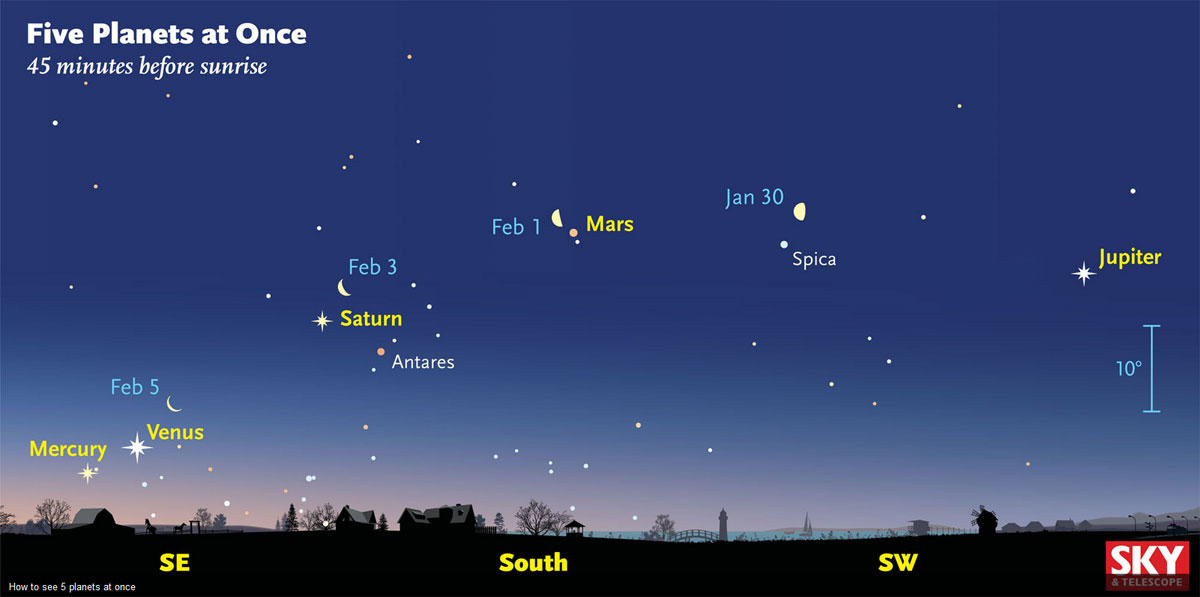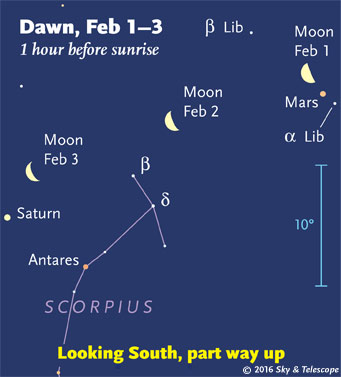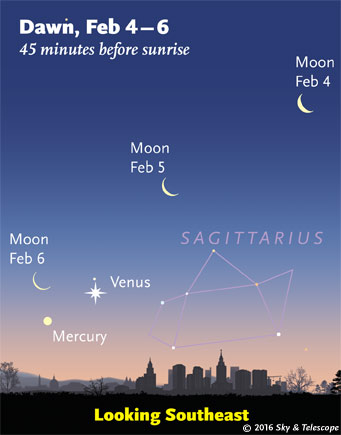This week's sky at a glance - 29th Jan to 6th Feb:

A panoramic view in early dawn this week. The waning Moon marches through the scene; it's plotted here only every other morning to reduce crowding. (The planet positions are exact for February 1st.) The blue 10° scale is about the size of your fist held at arm's length.
Sky & Telescope diagram
Sky & Telescope diagram
All five naked-eye planets are visible in early dawn — and Mercury is easier this week than last. See our article Get Up Early, See Five Planets at Once! Media and bloggers: Use the info and graphics in our press release.
Friday, January 29
• Sirius blazes high in the south on the meridian by about 10 p.m. now. Using binoculars, examine the spot 4° south of Sirius (directly below it when on the meridian). Four degrees is somewhat less than the width of a typical binocular's field of view. Can you see a little patch of gray haze there? That's the open star cluster M41, about 2,200 light-years away. Sirius, by contrast, is only 8.6 light-years away. No wonder it looks so bright.
• The eclipsing variable star Algol will be at its minimum light, magnitude 3.4 instead of its usual 2.1, for a couple hours centered on 9:05 p.m. EST.
• If you go out Saturday morning for the dawn planet panorama, you'll find the waning Moon upper left of Spica, as shown above. Off to their left, Mars will be 1½° above fainter Alpha Librae, a wide binocular double star.
Saturday, January 30
• As soon as it's fully dark, spot the equilateral Winter Triangle in the southeast. Sirius is its brightest and lowest star. Betelgeuse stands above Sirius by about two fists at arm's length. To the left of their midpoint shines Procyon.
And standing directly above Procyon now (depending on your latitude) is 3rd-magnitude Beta Canis Minoris, the only other easy naked-eye star of Canis Minor.

The waning Moon steps eastward from Mars to Saturn from Monday to Wednesday morning.
Sunday, January 31
• Algol should be at minimum light for a couple hours centered around 5:54 p.m. EST. Watch it brighten through the rest of the evening.
• Last-quarter Moon tonight (exact at 10:28 p.m. EST). The Moon rises around 1 a.m. tonight, in company with Mars. By the dawn of Monday the 1st they're high in the south. Look for 3rd-magnitude Alpha Librae (Zubenelgenubi) 1° south of Mars.
Monday, February 1
• In early dawn of Tuesday the 2nd, the Moon shines over the head of Scorpius about midway between Mars and Saturn.
Tuesday, February 2
• In early dawn of Wednesday the 3rd, you'll find Saturn and Antares below the waning Moon, as shown above.
Wednesday, February 3
• Orion stands high in the southeast to south these evenings, proudly displaying the sky's brightest orange-red supergiant, Betelgeuse, in his armpit. But did you know about the redder carbon stars glimmering faintly elsewhere in upper Orion? See the February Sky & Telescope, page 44, and tote out your scope.

The only sizable objects that are closer to the Sun than Earth is are Venus, Mercury, and (at this time of the lunar month) the Moon. See all three at once low in the southeast in early dawn.
Thursday, February 4
• In early dawn Friday morning the 5th, catch the crescent Moon pointing the way down to Venus and Mercury, as shown at right.
Friday, February 5
• On Saturday morning the 6th, the crescent Moon, vibrant Venus, and shy Mercury form a triangle low in the southeast, as shown here.
Saturday, February 6
• Bright Capella high overhead, and equally bright Rigel in Orion’s foot, are at almost the same right ascension. This means they cross your sky’s north-south meridian at almost the same time (around 8 p.m. now, depending on how far east or west you live in your time zone). So whenever Capella passes its very highest overhead, Rigel marks true south over your landscape. And vice versa.
No comments:
Post a Comment